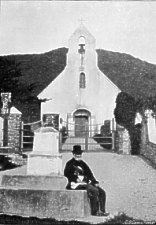
Maughold Church
[From Handbook En Route, 1899]
At Ballajora the line turns north-west; and there sweep sharply into view Maughold Head, a mile to the right ; the Vale of Lewaigue in the foreground ; the steep foot-hills of North Barrule on the left ; in the middle distance, Ramsey Bay, its farther shore receding to the Point of Ayre ; in the distance the south coast of Scotland, with a sea-interval of only fifteen miles from land to land.
Port Mooar, one of the scenes of Mr. Hall Caine's " Manxman,'' is a short half-mile below the line. Its shelving shores steepen rapidly towards the dome of Maughold Head, rising sheer some 400 feet on its seaward front ; and on the landward side has fertile farms.
The church of Maughold is of great antiquity. The north and south sides were taken down and rebuilt in 1860, the gables remaining unaltered. The east window has perpendicular work (fifteenth century), with a curious little lychnoscope window on each side. The west gable is of the true Manx type. Its doorway has jambs of Normanesque work, once support- ing an arch, but now having a runic cross as a lintel. In the Rushen Abbey Chronicle, under date 1160, the church is called "St. St. Machutus. " Several churches, however, stood in this churchyard, which contains five acres of ground, and is the largest in Britain. One of these, St. Maughold's, probably gave its name to the parish. An immense earth rampart is still traceable round the enclosure-conjectured to have defended a missionary station of monks from Iona who christianised the east side of the Island in the sixth or the seventh century.
The finest collection of runic crosses on the Island is at Maughold, within the churchyard gates. They date from the eleventh, twelfth, and thirteenth centuries, under the Orry kings.
The fine cross outside the gate on the north side, called " Maughold Cross," is of the XV. century. On the village green, west of the gate, is a sundial inscribed " Edward Christian, A. D. 1666. " He was the son of the famous Captain Christian, who figures in Scott's " Peveril of the Peak." Captain Christian commanded a ship in the Navy of James I. ; was Governor of Man; died in prison in Peel Castle (1662) ; and is buried at Maughold. They " belonged to " Ballakilley, the farm immediately west of the village.
That true poet, the Rev. T. E. Brown, whom the Island claims as its greatest literary artist, chose Maughold as his last resting-place. The slope Where in the 'sure and certain hope' Sleep the long rows." He died suddenly at Clifton in 1897, and was buried there-as in " some alien clime."
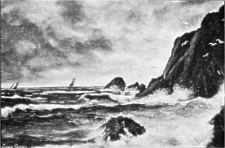
Maughold Head
North of the village, beyond the ridge, right on the edge of the cliffs of Ramsey Bay, is St. Maughold's Well, once resorted to for its curative " charm." The iron mines no longer worked, but formerly very productive, have tapped its springs; and the well is now dry.
Off Maughold Head, six miles away, is the Bahama Lightship. St. Bees Head is twenty-eight miles ; and in mid-channel is a buoy marking King William's Bank, on which (1680) a ship of King William III. took the ground when he crossed to Ireland.
The line runs along the fertile depression between Port Mooar and Ramsey Bay. Part of this district, called the "Staff-Land," was formerly held on the tenure of the safe custody of the " staff " of St. Machutus. This staff has long perished. In Scotland, however, there are instances of ancient bishops' pastoral staves preserved to the present day in families holding lands on this tenure.
On the right is Crowville, associated with the memory of Captain Hugh Crowe, a native of Ramsey, one of the most famous of- fighting "slavers." Among his numberless exploits, he once in a running engagement at night, on the "middle passage," kept at bay for eight hours two English men-of-war, taking them for " Frenchmen. "
On the left under the wooded hill is Lewaigue House, the seat for some centuries of an important branch of the Christians. In this house Mr. Hall Caine resided while writing " The Manxman, " many of the scenes of which are laid in this locality, especially at Ballure.
Across Ramsey Bay is the sea route from Liverpool, Fleetwood and Barrow, to Belfast and to the Clyde. The Bay, protected from all westerly winds, is the most frequented anchorage in the Irish Sea. The constant passing of vessels gives the outlook much interest.
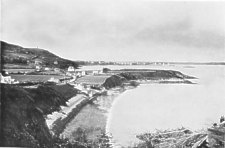
Port-e-Vullin and Port Lewaigue
On this slope are many pleasant houses over- looking Port-e-Vullin and Port Lewaigue, two pretty little strands between Maughold and Ramsey. On the low promontory between these strands are the remains of a battery defending Ramsey-but long ago dismantled.
Two foot-hills, the eastern pediment of North Barrule, abut steeply on the Bay: on the Maughold side Slieu Lewaigue, on the Ramsey side the Hill of Albert Tower. Between these is Ballure Glen, a large ravine of the most romantic beauty. The steeps, particularly of the latter hill, are densely wooded. Seawards the stream has cut an enormous gulch through the clay terrace overlooking the shore, over which road, and line pass close together from the eastern to the western side of the mountain range of the Island.
A cottage on the Maughold side of the bridge, a ruined mill beside the stream above it, and the old whitewashed mansion-house of Ballure on the Ramsey side, are some of the scenes of " The Manxman." The Ballure fuchsia is said to be the largest in the world.
Higher up in Ballure Glen, the ravine opens out, with cultivated fields around a long sinuous lake fed by streams from the side of North Barrule. An immense embankment across the glen shows that the lake is of man's work. It is the reservoir of Ramsey water-works; a retired and peaceful tarn embosomed among the heights, and reflecting the varying aspects of hill and sky.
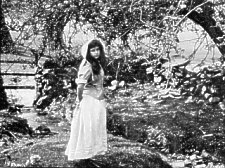
Blossoms in Ballure
The path up Ballure Glen is for choice the most charming way to Albert Tower; which, however, is more easily reached from the Terminus at Ramsey, by way of Elfin Glen.
The tower overlooking Ramsey was built to commemorate a Royal visit in 1847-of the Queen and Prince Albert. The Royal squadron anchored in the Bay. Only the Prince came on shore. He landed on the beach and asked a townsman to conduct him to the hill-top. It is a most charming view-point : inferior to the summit of North Barrule and to the crest of Sky Hill westwards. But those points are both incomparable.
The Prince was fortunate in the view-and in the guide, who was a barber, an exceptionally polite as well as most intelligent man. The guide was equally fortunate. Having had the distinction of being the only person to hold conversation with the Prince, his fame was ac- companied by substantial business advantages. On board the Royal yacht, the Bishop (Lord Auckland) was the only person received by the Queen, the others remaining at the gangway. The Governor (Hon. Chas. Hope), who resided at Castletown, on hearing of the Royal yacht being in Ramsey, posted at a gallop to the north, but was too late. As his carriage whirled down Lewaigue Hill the Royal squadron was seen under weigh off the Bahama. In " Leaves from the journal " the Queen has succinctly chronicled this visit.
"Monday, Sept. 20. (1847.) At half-past eight anchored in Ramsey Bay. Albert went on shore, and meantime the Bishop of Sodor andMan, with others, carne on board. Albert returned at twelve. At one o'clock we started again."
The mountain road winds up past the tower, and skirts the western side of North Barrule- the best route for the ascent. From the summit the coast of England from Furness to the Solway, and of Scotland from the Solway to the Mull of Galloway, are distinctly seen. The intervening sea seems but a narrow strait. Magnificent views of the Cumberland and the Galloway mountains fascinate the gaze ; while underneath lie the northern parishes of the Island like a vast carpet patterned with farms.
In the fields under Albert Tower Hill is old Ballure church, till 1820 the town church of Ramsey. The site is ancient ; but the church has been twice rebuilt. Its afternoon service is a favourite resort of visitors to Ramsey. The stunted tower of the modern town church of St. Paul's, fronting the large market-place square, and the masts of the shipping in the harbour, are visible over the intervening roofs.
To Albert Tower the direct way is from the Electric Railway Station to the hill-foot; then by a choice of ways-either by the new mountain road, or by Elfin Glen.
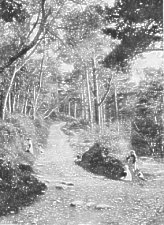
Road to Albert Tower (Elfin Glen)
The immense quarries where the building stone of Ramsey is obtained, are on the right. The Lovers' Walk ascends Elfin Glen by easy turns, emerging on the brow of the hill, where a stream from North Barrule drops over a ledge to murmur through its shaded recesses.
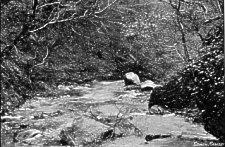
Elfin Glen
Ramsey is a Norse name-Hrafns-a, or Raven's Harbour. The days of the Norse Viking fill many a page of the early history and romance of Manxland. Godred Crovan, the Manx " William the Conqueror," landed at Ramsey and won the Island on the battlefield of Sky Hill. At Ramsey Olaf I. fell by the treacherous stroke of a battle-axe.
The great Somerled of Argyle with a fleet of 6o ships lay here in 1162, having defeated Godred II. of Man, who was also King of the Dublin Danes. King Robert Bruce landed at Ramsey, and marched by way of Douglas to attack Castle Rushen. William III. of Orange crossed Ramsey Bay on his expedition to Ireland when he won the Battle of the Boyne. King William's Bank is in mid- channel, north-east towards Cumberland.
In 1760 Ramsey Bay was the scene of a famous triple sea-duel between three English
ships under Commodore Elliot, and three French ships under Thurot. The Frenchmen all three hauled down their flags after
an hour's fight ; and the six ships were brought to an anchor in the Bay. In Ramsey they still
" . repeat the story
Of that gallant Commodore."
Of a different turn is the story of the "Tiger," a Ramsey privateer in the old war with America. Too eager for blood and plunder, she captured a Dutchman on the high seas- with the rueful result that Holland petitioned England for redress, and the Manx privateer had to pay an utterly ruinous indemnity.
Ramsey is a romantic town.
(Chorus.) " Ramsey Town,
O Ramsey Town,
Shiningby the sea !
Here's a healthy my true love,
Wheresoe'er she be!"'Twas once I loved a lass,
I swore I loved her true,
And so I did, so long as we
Held Ramsey Town in view." Her hair was like the gold,
Her eyes, like cloud, were grey;
We sailed away for the blazing South,
All on a Summer's day." No grey eyes southward are,
Nor locks of curly gold ;
But in the flash of eyes of jet
Lies wealth of love untold." My heart is not so small
To stop at one, good lack !
I'll love them all, or twenty such
Grey eyes or brown or black.
("MANX NATIONAL SONGS." Ed. W. H. Gill.)
The harbour is the tidal estuary of the Sulby river, with a most picturesque bend at the market-place. Coasting steamers, schooners, ketches, sloops, and a chance Norwegian brig give it a busy air of trade. The Isle of Man Steam Packet Company's boats sail to Liverpool and to Whitehaven ; the latter a pleasant run of two and a half hours. Cruising yachts also make Ramsey a favourite place of call in the season.
Inevitably the harbour mouth and its piers with port lights, break the continuity of the shore. On both sides from the harbour sea- promenades front the Bay. That towards Ballure is the sea-front of Ramsey proper. It terminates at the Queen's Pier, a magnificent low-water landing pier, running out half a mile into the Bay. The Queen's Pier was erected in 1887 at a cost of £50,000. Further towards Ballure is the ladies' bathing shore, absolutely perfect in every imaginable way.
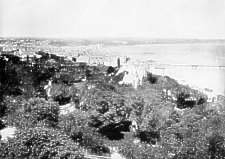
Ramsey Bay
Two bridges connect Ramsey with its suburb north of the harbour-the grand swing-bridge above the market-place, and the old stone bridge on the. Sulby river higher up ; the former leading to the Mooragh, the latter to North Ramsey and the northern parishes beyond. In sinking the foundations of the Swing Bridge much difficulty was experienced by reason of the treacherous nature of the ground and the cost to the town was enormous. Formerly the Sulby river entered the sea by a different course-between the sandy hills of North Ramsey and the Mooragh. At an enormous outlay the old river-course has been made a beautiful tidal lake, and the Mooragh laid out with boarding-houses fronting the north shore.
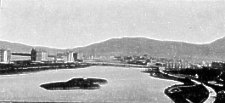
Mooragh Lake
The tidal lake, overlooked by the villas on the brows of North Ramsey and surrounded by a beautiful park sheltered from all westerly winds, is a favourite place for boating, being perfectly free from risk. It is also a paradise for the juvenile yachtsmen who sail model yachts.
From the Mooragh for seven miles, as far as the Point of Ayre, stretches the superb curve of sand and strand and rose-hued sea-brows of the North Shore, including parts of the sea- board of three parishes. The brows reach their greatest height of some zoo feet at Point Cranstal, where the hills of Bride abut on the bay. This is a favourite bathing shore, all that ~` is necessary being the provision of a light bathing tent. Indeed, with such free scope of r: space even a tent may be dispensed with. For idle hours a delightful footpath leads along the brows with roamage free as air.
" Till he saw his chance, and afore you'd be knowin
His helm was up, his jib was drawin,
And a lift and a leap and a jerk and a joult,
And he sent her in like a thunderboult."-(T. E. B.)
The Lifeboat House is on the Promenade near the harbour-a handsome, well-equipped edifice built by the generosity of Mr. and Mrs. Norbury of Port-e-Vullin. The achievements of this lifeboat have a distinguished place in the annals of the National Lifeboat Institution; and the character of the crew stands unsurpassed for fearless promptitude and tenacious endurance in its heroic work of stress and storm. Ramsey is indeed the cradle of brave seamen.
" Then-as an angel springs,
With God's breath upon his wings-
She went;
And the black storm robe was rent
With the shout and with the din
And the horror and the roar,
Rolling in, rolling in,
Rolling in upon the dead lee-shore."
The Rev. T. E. Brown, the National Poet and genius of Manxland, resided in Ramsey the last five years of his life (1892-7)-in a house overlooking the Mooragh Lake.
In every direction Ramsey has delightful surroundings. North to west lies a plain-on which the hills are seen abutting with bold fronts, clothed with woods and pastures, broken by alternations of craggy brows. Near the hills the flats are richly timbered, as far out as the Sulby river. ao
A famous lane and field path makes a detour by the hill-foot through Claughbane, to Glen Aldyn Road near Milntown House. The lane is shaded by avenues of fine timber. The banks abound with primroses, violets, vetch, fairy-flower, and a score of other little wildings. On the banks the thorn, dog-rose, foxglove, and honeysuckle, observe " their season due " ; while on the hills and steeps the gorse is always the dominant note of landscape colour.
The Ramsey Golf Links occupy the pasture lands of " Milntown Flats," the Club pavilion being on the Lezayre Road, the continuation westward of Parliament Street towards Sky- Hill.
It would be impossible to find anywhere a golf ground with more delightful surroundings. There is not a feature of natural scenery, some glimpse of which may not be obtained by with- drawing one's eyes for a moment from the fascination of the game. Mountain, hill, crag, wood, ravine, gorge, and glen; upland sheep- pasture and lowland meadow ; mansion, farm- house, cottage ; plain and village spire ; river, port, and shipping; headland and sea ; and on the horizon other coasts and mountains.
The golf course was laid out by the well- known expert, Mr. Tom Morris, of St. Andrews. It is for choice made the meeting place of Insular golfers in their inter-club competitions. That visitors to Ramsey have facility afforded of playing on the links-goes without saying.
Milntown stands near the foot of Sky Hill. Southward the noble vista of Glen Aldyn extends some four miles into the heart of the mountains, the head of the glen being only a little way short of the skirt of Snaefell.
The walk into Glen Aldyn is well worth a day of one's life. Indeed life is too short to throw away a chance of seeing Glen Aldyn. The left fork, which itself forks again, contains the Manx " Niagara--a misnomer for " Yosemite "-a slender fall, but of great height, in a lovely seclusion. The main glen is stern and wild for two miles, when its gradient steepens sharply to the mountain wastes.
The ridge of Sky Hill is the traditional battlefield --the Manx " Senlac " - on which Godred Crovan won the Island (1075). Sky Hill is beautifully wooded. So it was eight centuries ago-as is indicated by its Norse name " Skogar Fell " (wood-fell).
The seat of the Christians-the family which has figured with most distinction in Manx history--was formerly called Altadale : in modern times changed to Milntown. A Christian was Deemster five centuries ago ; and the office became almost hereditary. William Christian, celebrated in ballad as " Iliam Dhone " (Fair William), was the son of Deemster John Christian. He was born 1608 ; raised the Island in arms 1651 ; and was executed 1662, soon after the Restoration.
Past Sky Hill is Lezayre church with ivied tower rising above the woods. On the flat is Ballakillingan-the old seat of the Curpheys. Ewan Curphey married a sister of " Iliam Dhone," and joined him in the Rising of 1651. The Lezayre hills and Sulby anciently belonged to the Abbey of Rushen. A branch monastery was at Close-yn-Ellan : but no ruins remain on the site.
The whole district of Sulby is singularly bright and beautiful. The river here emerges from the mountains, but does not leave them. From its debouchure it bends eastwards and flows to Ramsey, never far out on the plain. The main source of the Sulby river is on the divide of the Island at the western end of Snaefell, near the point where the Electric Railway crosses the divide in its ascent.
Between Sulby and the sea, westwards, are the Curraghs-a region once wholly under water; now reclaimed and intersected by roads. This district is worth exploration, especially for the botanist. The landscape painter who affects far-extending levels, reeds, rushes, and standing waters, will find here perfect "fen pieces." The " picturesque " tourist will be charmed to find on the Island scenery of this variety.
The parish church of Andreas has a tall Italian campanile visible all over the plain. Invaluable fragments of runic crosses are preserved in the church. The district is rich in antiquarian interest, among which are the " Crannogs," or lake-dwellings, on the meres that formerly covered the meadows.
Bride is the north end of the Island. A low rampart of dunes covered with velvet sward lies east and west across the district : and Kirk Bride village nestles at the foot of these dunes on the north side, completely shut out from the world-four miles from Ramsey and three miles short of the Point of Ayre. As at Andreas, the runic crosses here are bilt fragments : but very precious both in their designs and inscriptions. For example, with the Cross of Truian is identifiable the homestead of Glentruian, near Kirk Bride church. The north and west parts of Bride are " the Ayre."
" Over a desert of sand and shingle, the lapse of ages
" laid a mat of soil and a carpet of grass intermingled
" with trefoil and thyme, and tiny flowers of faint
" hue and tiny herbs of delicate fragrance. Over this
" there came a growth of dwarf gorse and heather, leaving
" only patches of the old turf around the margin of the
" desert. The gorse and the heather come into blossom
" together as Autumn approaches. Far as the horizon
" the waste extends in yellow and purple sweeps. Around
" it all is the gush and sigh of the tide on the shingly
" beach, breathing and uttering-of the pathoses of
"eternal vicissitude and succession in human existence."
"CAPTAIN OF THE PARISH.
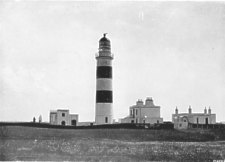
Point of Ayre Lighthouse
The Point of Ayre ''light" is one of the finest on the British coasts. The light-keepers are civility itself-simple, brave, faithful men, who " guard the light from all eclipse." Near the lighthouse is the fog-signal station and not far off the recently discovered salt mines. It will well repay the sacrifice of another hour to turn aside to visit Port Cranstal, a little fishing hamlet on the shore of Ramsey Bay. The homes, the life and environment, the people themselves-will linger tenderly in the pleasant memories of " Ellan Vannin Veg Villish Veen ! "
I'll tell you the Island and port of the main,
That I long in my heart to go back to again
My boyhood to recall and my years to forget,
The haven of my heart that I mean to sail to yet.
Isle of Man ! Isle of Man !
Its hills all in purple and its fields all in green,
And the gorse in golden glory on the hedges all between;
The roses all in bud, and the thorns all in flower-
I should like to be again on the Island for an hour.
Isle of Man ! Isle of Man ! "
|
|
||
| |
||
|
|
||
|
Any comments, errors or omissions gratefully received
The Editor HTML Transcription © F.Coakley , 2008 |
||